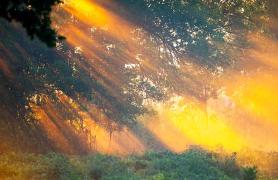
If you are longing for an outdoor adventure, but the daytime summer heat has you feeling like a couch potato, we have the solution. Time for you to check out Missouri’s nightclub nature! That might seem counterintuitive to humans, who are diurnal — or active during the day — but nature is not. It’s open and active 24 hours a day. At nightclub nature, the temperatures are cooler, the atmosphere is mysterious, and the animals are not often seen or heard in the daytime.
Who’s at Nightclub Nature?
Mammals
Bats are always out at night, particularly little brown bats and red bats. These nocturnal mammals help control the pest population, making your visit outdoors more enjoyable. Starting at dusk, look for them where flying insects are plentiful — over bodies of water, above meadows and clearings, near barns, and streetlights. Their flight patterns are erratic and fluttering, matching the dance of their prey.
Small prey mammals, like flying squirrels, are also out at night, but aren’t as obvious as bats. You may not catch a glimpse of these gliding pint-sized furballs, but if you stay quiet, you might hear them. Late at night near a woodland stream, listen for a high-pitched tseet repeated in three- to five-second intervals or a musical chirping. Another tell-tale sign that a flying squirrel is near is the soft thump of a small body landing against a tree.
Mammals that we see during the day often make an appearance at night. Larger wild mammals — such as deer, raccoons, foxes, coyotes, opossums, skunks, beavers, bobcats, and badgers — are known to enjoy the night life. But they become more skittish as the sun goes down. Most interactions are accidental — a coyote howling in the distance, an opossum caught in a car’s headlights, a raccoon jumping from a dumpster. If you want to be more purposeful about sighting these mammals, take a hike at night, armed with a flashlight. Find a spot to sit and stay quiet, taking in the sights and sounds.
Snakes
Nighttime is prime time for snakes. On summer nights, snakes come out to hunt their prey, such as insects, mice, and frogs. Don’t let the thought of a snake crossing your path or gliding across a moonlit pond deter you from heading out at night. It helps to remember that snakes are shy and nonaggressive. If you encounter any snake at night — venomous or not — simply back away and watch from a distance.
Frogs and Toads
If there is a soundtrack to Missouri’s nightclub nature, it is supplied by the frogs and toads. Missouri’s toads and frogs must mate and lay their eggs in water, so any fishless pond, flooded field, or ditch will do. These amphibians gather in spring and the frog-and-toad concert begins. Voices often heard in this nighttime performance include spring peepers, boreal chorus frogs, cricket frogs, bullfrogs, and American toads.
Spring peepers emit a piercing peep about once a second while chorus frogs sound like a thumbnail running across the teeth of a pocket comb. A cricket frog makes a clicking sound, gick-gick, like two pebbles struck together twice, and a bullfrog’s baritone is a deep, bellowing ger-rrr-um. The American toad has a high-pitched trill lasting six to 30 seconds.
If you would like to see the critters making these sounds, head to a pond, armed with a flashlight. Walk slowly and quietly and you may catch the eyes of these masterful musicians.
Plants
Looking for plants in the dark may seem odd, but some plants and fungi were made for the night.
Evening primrose is known as a nightblooming flower. Its large, lemon-yellow flowers open at sunset and close by mid-morning. It is sweet-smelling, attracting night pollinators like the hawkmoth, which resembles a familiar daytime pollinator, the hummingbird.
Glowing fungi is another plant made for the nighttime. Fungi, like honey mushrooms and jack-o’-lantern mushrooms, release a glow of cold light thanks to a chemical reaction between oxyluciferin molecules, an enzyme called luciferase, and oxygen. This phenomenon is known as bioluminescence, and it’s also used by fireflies to light up their backsides. Fungi use bioluminescence to attract insects that help spread their spores while fireflies use it to attract mates.
Insects and Spiders
If frogs and toads are the soundtrack to nightclub nature, then insects provide the backup. Though you may have a hard time spotting these boisterous bugs, head out and stay quiet and you can hear them. Much of this noise is made by breeding male crickets and katydids. Crickets produce musical, evenly spaced chirps, while katydids make a raspy ch-ch or ch-ch-ch sound (to the rhythm of ka-ty or kay-ty-did). Groups of katydids sometimes call in unison, so the sound seems to pulsate through the night air.
Most spiders are nocturnal hunters, whether they hunt on the ground, like wolf spiders, or spin a web to snare their prey. To find spiders in the dark, go on a spider hunt! Shine a flashlight into grass or other low vegetation and you may catch the eye of a spider. Wolf spiders, fishing spiders, and crab spiders all have eye shine. Web-building spiders don’t, but their webs will glitter by the glow of a flashlight.
Flip on your porch light and wait for some of Missouri’s largest, most colorful moths — the luna moth and the polyphemus. The pale green, long-tailed luna month and the reddish-brown polyphemus, with its dramatic eyelike wingspots, can’t resist the warm glow of a porch light. Sometimes, the party lasts until dawn, and you will wake up in the morning and find these moths still resting on the side of your house.
Birds
Birdwatching is a popular daytime activity. You can take those skills into the night but call it bird listening.
Owls are the best-known night-calling birds, and the voices most often heard are those of the barred, great horned, and screech-owls. Barred owls make the distinctive hoot-series hoo hoo hoohoo, hoo hoo hoohooahh, which sounds like, “Who cooks for you? Who cooks for you-all?” The call of the great horned owl is a low-pitched series of four to six hoots. Screech-owls don’t really hoot. Rather, their call is a descending whinny or one long, quavering note. The easiest way to hear owls is to drive out to the country around dusk and stop at a place near both fields and woods. Roll down the car window and listen for calling owls.
Train your ear to pick up the sounds of these nocturnal birds:
Whip-poor-wills are easy to spot as they announce themselves over and over — whip-poor-will. With a flashlight, you may catch their red eyeshine on roads in wooded areas.
Nighthawks are easy to identify from their call — a harsh, nasal peent — and from their darting, swooping flight. Look for them around streetlights and above native prairies and Ozark glades.
Catbirds and mockingbirds imitate everything from a lost kitty to other birds.
The male woodcock makes three distinct sounds during its mating display at dusk. First, on the ground, a peenting call. Then a musical twittering, created by its wings as it spirals high into the air. Finally, an encore of twittering and chirping as the woodcock zig-zags back to the ground.
Great blue herons, huge storklike birds, cry in a low, harsh gwok. Look for them around lakes, ponds, rivers, and marshes.
Most bird species migrate at night, in spring, and fall. On clear nights, watch (and listen) for flocks of geese and other birds as they pass across the face of the moon.
This is just a sample of what you might find in Missouri’s nightclub nature. It is like a whole new world when the sun goes down. What will you discover?
Tips for Wildlife Watching at Night
Be safe. Scout your observation area in the daytime. Don’t hike alone at night and tell someone where you are going and when you will be back.
Be equipped. Bring a flashlight with fresh batteries. Try covering the lens of the flashlight with red plastic wrap, fastened with a rubber band. (Most night animals can’t see red light.) An audio recorder for night sounds and binoculars to see wildlife at dusk are also fun for wildlife-watching at night.
Be comfortable. Wear sturdy, closed-toe shoes and warm, layered clothing. Insect repellent, a plastic garbage bag to sit on, a water bottle and some snacks will also make your hike more enjoyable.
Be quiet. It’s best to settle down quietly in one place for 20–30 minutes. It typically takes a human’s eyes that long to get fully dark-adjusted.
Be patient. It’s great to encounter creatures of the night, but it’s just as important to slow down and soak in the benefits of nature.
See What?
If it takes a human’s eyes 20–30 minutes to adjust to the dark, how can animals see in the dark? Nocturnal (or night active) and crepuscular (or active at dawn and dusk) animals are quite at home in low light thanks to three special adaptations.
First, nocturnal creatures often have very large eyes, which gather more light. Compare an owl’s huge eyes with the smaller eyes of a hawk, which may hunt the same fields as the owl during the day.
Second, with fewer cones and more rods, the structure of a nocturnal animals’ eyes is different. Cones pick up colors and sharp details; they require bright light to function. Rods are more useful at night because they work in dim light to detect shapes, movement, and shades of gray.
Third, many nocturnal animals have a mirrorlike reflective layer behind the retina of the eye, called the tapetum. This layer reflects light back to the retina, and then out of the eye. This means the retina is struck twice, once by incoming and once by outgoing light, so that objects seen at night look brighter. The tapetum is also the reason for eyeshine. Eyeshine color can sometimes help identify an animal at night. For example, if your flashlight reveals two tiny red eyes high in a tree, you have spotted a flying squirrel. As you drive at night, look along the road for the eyeshine of deer (yellow), opossums (orange), and whip-poor-wills (red).
These visual adaptations allow them to travel, feed, and find mates in very low light.
Content for this article was taken from Nature’s Night Shift by Barb Bassett, published in 2008.
Outdoor Missouri doesn’t close when the sun sets














Also In This Issue

Summer solstice welcomes a season of adventure

A hidden gem for bass fishing in northwest Missouri
And More...
This Issue's Staff
Editor - Angie Daly Morfeld
Associate Editor - Larry Archer
Photography Editor - Cliff White
Staff Writer - Kristie Hilgedick
Staff Writer - Joe Jerek
Staff Writer – Dianne Van Dien
Designer - Shawn Carey
Designer - Marci Porter
Photographer - Noppadol Paothong
Photographer - David Stonner






















